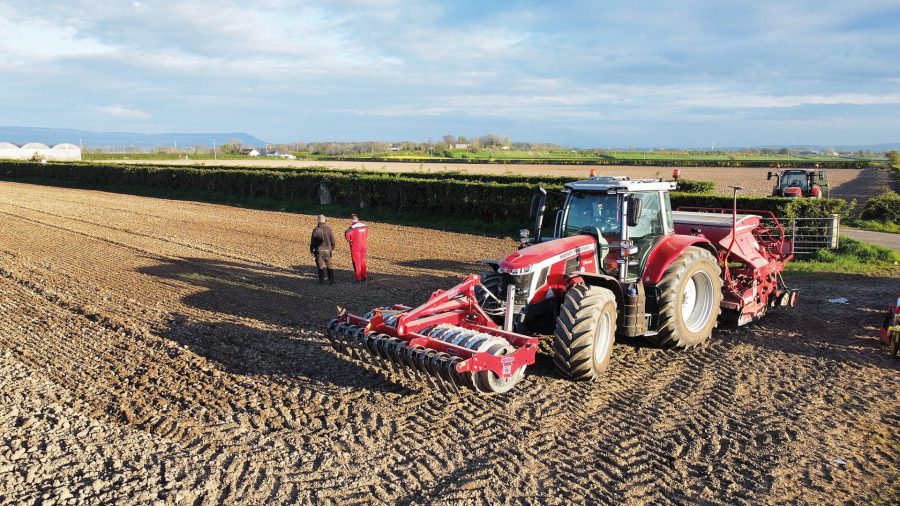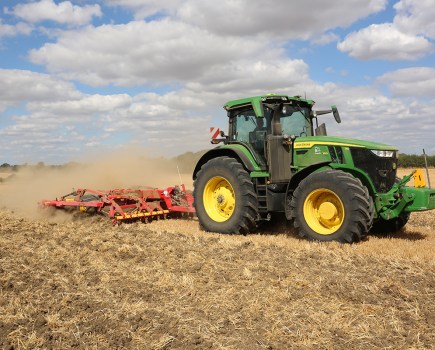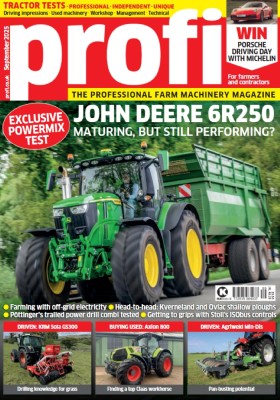REPORT: Utilising modern tyre technology is allowing Mark Fulton to minimise compaction on his Northern Ireland farm, including an area of heavy land reclaimed from the sea. So, in reality, how much difference do the tyres make?
With soil types ranging from moss to heavy clay, some of which is reclaimed seabed, Mark Fulton has always had a keen interest in reducing compaction by using the latest tyre technology. As such, Mark was one of the early adopters of VF or very increased flexion tyres.
While the farm had a largely livestock focus with both cattle and sheep, this changed to an all-arable enterprise in 2009. However, the phrase of ‘all your eggs in one basket’ rang true for the farming business based in Dungiven, with plenty of rain in this area of Northern Ireland. Since then, there has been a switch back to a more mixed approach, though cropping still has the majority share.
“I’ve always had an interest in machinery, and we do pretty much all our own work,” explains Mark. “The only job that is always left to a contractor is hedge cutting, although we’re not afraid to call in extra help if we need it … like this year when we hired in a contractor with a combine to help with the rapeseed while we sorted out a side knife issue on our machine.”
This penchant for machinery has resulted in a decent fleet of kit, although a shed fire a couple of years back has led to a certain amount of restructuring. For instance, the Lexion 660 was replaced with a New Holland CX7.80, and the fire also resulted in the arrival of new tractors, too. The Horsch 4AX sprayer was replaced with the same again.
Crops in
There is no rigid policy when it comes to crop establishment. The first tool in the field is either a four- or five-furrow Kverneland (a 3300 or ES85) or a 3.0m Sumo Trio.
“We judge what way to go field by field and season by season,” explains the farmer. “The only real exception is the rapeseed stubble where I go straight in with the Trio. And when we had potatoes grown on our land I would always plough to deal with the large amounts of trash. We have tried a green cover in one of our heaviest fields but it left the soil structure very open with no body, which then caused issues harvesting the following crop. If we are required to grow cover crops in the future, it’s something we will have to look at again, but with our late harvest we don’t have much of a growing window for them.”
A pair of Puma 225 CVXs had been tasked with the heavy field work, one shod on a familiar configuration of 540/65 R30 front and 650/65 R42 backs, allowing it to easily slip into the plough furrow. The topwork tractor, though, has been booted on 710/55 R30, 900/50 R42 MachXbibs. It’s a duo that has served the farm well and, by being an identical pair, they could also share a set of 600/60 R30, 710/60 R42 XeoBibs.
“I wanted a large versatile tyre that we could leave on the tractor for other work, and the XeoBib did that,” says Mark. “It is a choice that has worked well. By their design, the VF tyres can be operated at pressures as low as 7-14psi for field work and then work at speed while travelling back to the yard,” he comments.
Up until 2016, crops were being sown with a 4.0m Väderstad Rapid, but, following the wet autumn of 2016, the farm couldn’t get much drilling done so it was changed to a 3.0m Horsch Express 3KR power harrow drill combi. The new drill is now handled by a new tractor and a return to the Massey Ferguson marque. The 7S.180 Dyna-6 has also been specified on XeoBibs, 600/60 R28s and 710/60 R42s, to better match the lower horsepower tractor’s frame. These, too, allow the pressure to be reduced, although, because of the weight of the Horsch drill and Sumo front packer, they are being operated at 9-14psi to handle the load when both are raised out of work.
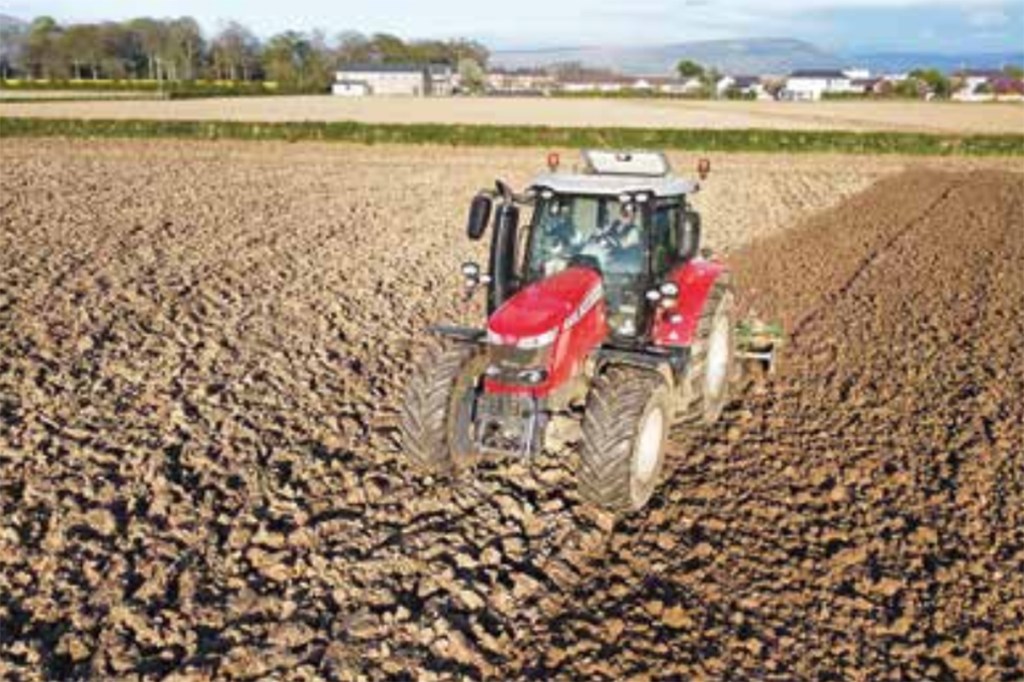
The four-cylinder 6718S was breaking down ploughing with a demo Tolmet disc when pictured, but the plan has since changed to hiring this type of cultivator if it’s needed. The tractor is already on Multibib tyres, but Mark says he would prefer to see this Massey on VF tyres rather than fit different rubber to the combine. Mark reckons the harvester is performing fine on the 800 Mitas it was supplied with.
Puma still purring
The decision to purchase the Massey was down to the time it took to repair the Puma 225, which was on the bigger tyres. It had various bits of damage caused by the blaze. But on our visit both of the Case IH tractors were in action. One was busy ploughing the heavy land, which had received cattle muck a few days previously. You can see in the photos just how heavy this land is.
At the time, Mark was considering adding a short disc harrow to his armoury — to help break down the ploughed ground. But this wouldn’t do anything that the Sumo Trio couldn’t achieve, which was also in action on the other Puma.
“I think we have enough machines at the minute, and, if I need a disc harrow, we can hire one from a business just 10 miles away,” explains Mark. “We will probably start doing more min-till now, as I can see where we have done it we have a healthier, stronger crop. We did park up the Trio for a couple of years, when we were using a lot of chicken muck, for fear of botulism, but we’ve been relying on it more over the past three or four years. We’re also chopping a lot more straw now — there’s only been 12ha of straw baled to date this year with no spring barley cut as of yet, and I plan to chop a proportion of that, too. In a season like this it can take a lot to salvage the straw. It’s not worth it.” The sprayer hasn’t escaped Mark’s quest for lower compaction, either: the Horsch 4AX is fitted with 650/60 R42 XeoBibs, which it lives on all season. The farmer had to source these wheels, as they were just launched at the time of the sprayer’s arrival, but they have proved to reduce tramline wheelings. The plan is to place the 6718S, which does the spraying, on similar tyres.
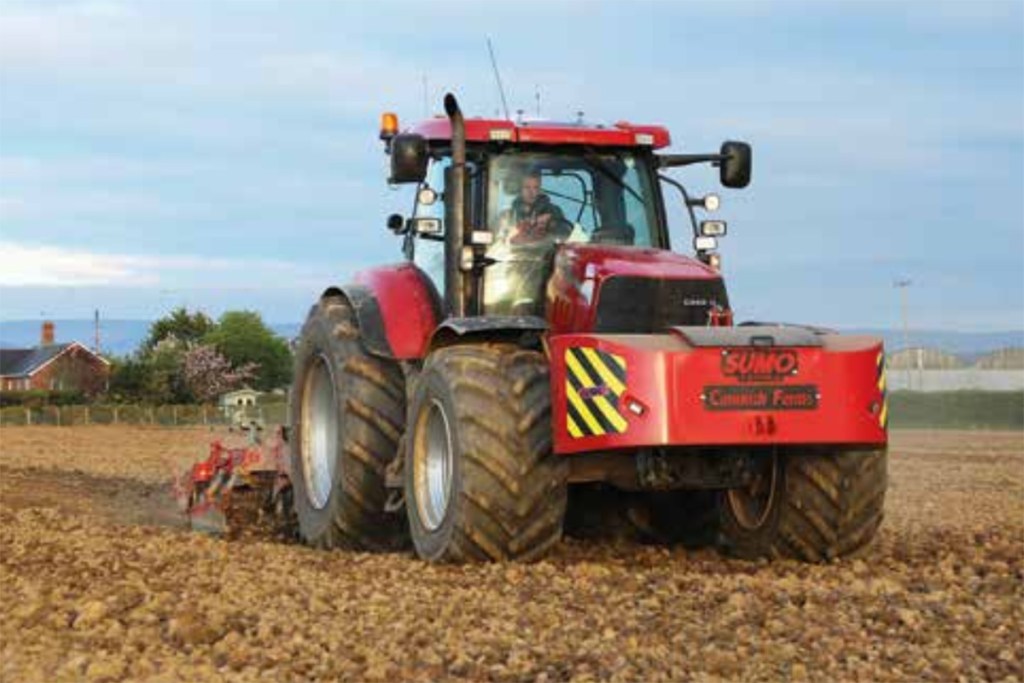
Michelin MachXbib tyres are fitted on the second Puma, which has been predominantly employed on top work. But it also shares a pair of 600 and 710 XeoBibs with the other Puma.
Reducing field traffic
When it comes to shifting the straw, Mark has purchased a Ritchie Traileyre at what he describes as reasonable money. With its wide-ish 500 tyres, the single-axle, six-bale chaser can fetch the bales from the field.
This is operated behind a 100hp tractor to keep the outfit as light as possible.
“All of the farm’s trailers are on CargoXBibs, plus one of the bale trailers, while two of the older bale trailers are on 560 BKTs,” explains Mark.
“The trailer tyres can run with 18 to 24psi compared to 100 to 120 psi with the razor blades you see on some trailers. There is also a big difference in the weight of some forklifts: there’s 2.1t between our JCB 526 on 460/70 R24 tyres and the 538 on 500/70 R24 XMCL Michelins.”
Self silage
As well as shifting the straw bales, the flat trailers are used for moving the silage bales, because the farm does a mix of both clamp and bales for its winter fodder to feed the sheep and cattle on Camnish Farm.
The baling is left to a fixed-chamber Massey Ferguson 2125S, which also packs away the straw, while the wrapping is done with a McHale. The bales are either hauled back to the yard with the trailers or stacked in the field if that’s where they’ll be needed. For pit work, a Pöttinger Mex VI trailed does the chopping.
“All the silage kit is there from when we had more livestock,” explains Mark. “I feel that, as a smaller livestock producer, I won’t be able to get a contractor when we need them, and our yard is not suitable for a Jaguar 980 getting it all done in a couple of hours.”
Summary
We’ve become accustomed to arable farmers talking about VF and IF tyres as a way of reducing compaction. Perhaps this is because it is visually easy to see the effects of both the size of the tyre and the pressure it is operating at when on land that has been loosened with a cultivator or plough. However, Mark Fulton points out that there is no point having the best tyre technology available on the farm’s tractors when a trailer
and telehandler are then following behind on narrower, high-pressure tyres. And this same logic is also being applied to the farm’s grassland, where Mark looks to minimise traffic and operate low pressure tyres to spread the weight and protect his soil.
For more up-to-date farming news click here and subscribe now to profi and save 47%.

